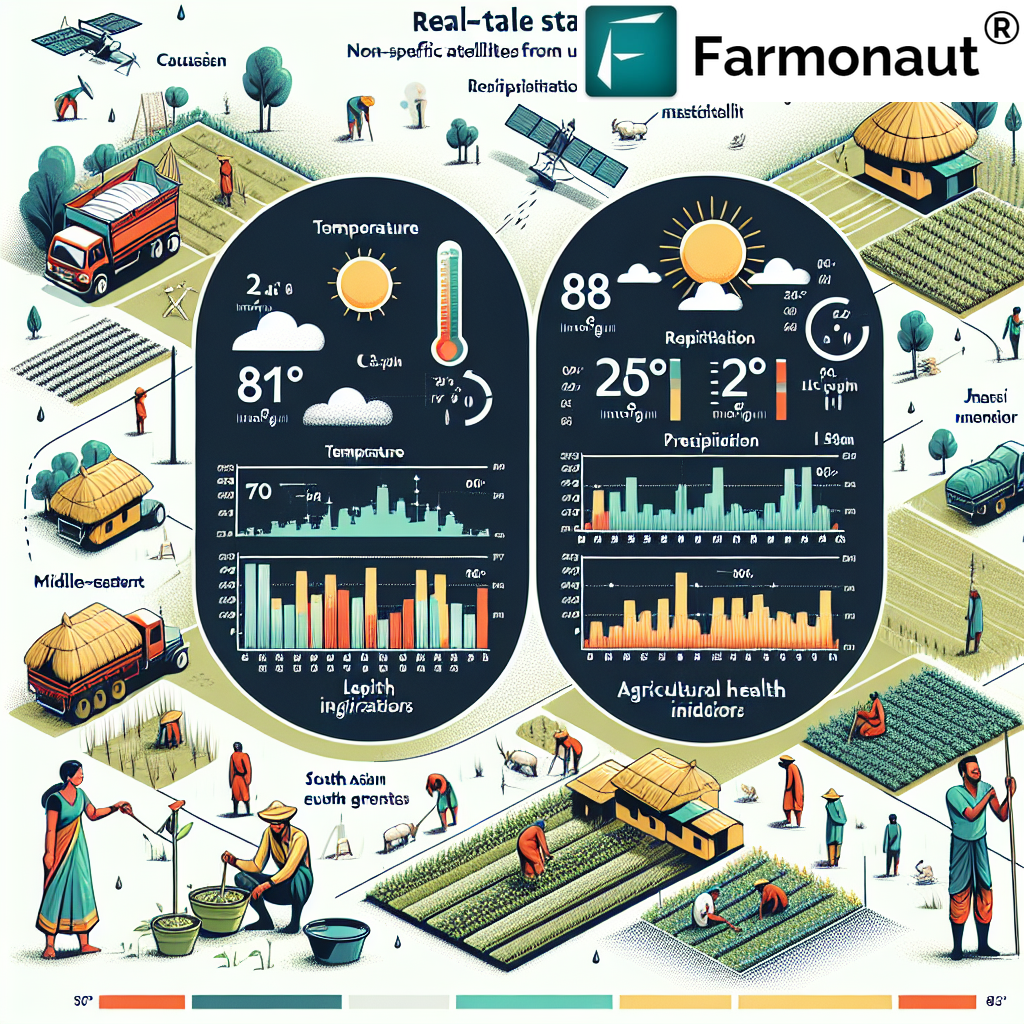Here’s a comprehensive blog post incorporating the requested elements:

Unlocking Indian Agriculture: Satellite Weather Insights from Gulbarga to Navsari
In the vast tapestry of Indian agriculture, weather plays a pivotal role in shaping the fortunes of millions of farmers. From the arid landscapes of Gulbarga to the fertile plains of Navsari, understanding and predicting weather patterns has become increasingly crucial. At Farmonaut, we recognize the importance of harnessing cutting-edge technology to empower farmers across the nation. In this comprehensive exploration, we delve into the world of satellite-based weather monitoring and its transformative impact on Indian agriculture.
The Revolution of Satellite Weather Monitoring in India
India, with its diverse agro-climatic zones, presents unique challenges and opportunities for agriculture. The advent of satellite weather monitoring has ushered in a new era of precision farming, allowing us to overcome many traditional barriers. Let’s explore how satellite technology is reshaping the agricultural landscape across different regions of India.
Gulbarga Weather Satellite: Transforming Agriculture in Karnataka
Gulbarga, now known as Kalaburagi, is a crucial agricultural hub in Karnataka. The region’s semi-arid climate makes it particularly vulnerable to weather fluctuations. The Gulbarga weather satellite data, integrated into Farmonaut’s platform, provides farmers with unprecedented insights into local weather patterns.
- Real-time monitoring of rainfall patterns
- Early warning systems for drought conditions
- Customized crop advisories based on satellite data
By leveraging this technology, we’ve empowered Gulbarga’s farmers to make informed decisions about planting dates, irrigation schedules, and crop selection. This has led to significant improvements in crop yields and resource efficiency.
Hoskote Weather Satellite: Precision Farming in Bengaluru Rural
Hoskote, located in Bengaluru Rural district, is known for its horticulture and floriculture. The Hoskote weather satellite data plays a crucial role in supporting these high-value crops. Our integration of this data allows farmers to:
- Monitor microclimatic conditions crucial for delicate crops
- Predict frost events and take preventive measures
- Optimize irrigation for water-intensive crops
The precision offered by satellite monitoring has been particularly beneficial for Hoskote’s grape and flower cultivators, enabling them to maintain high-quality produce consistently.
Indian Satellite Weather: A Nationwide Perspective
The broader context of Indian satellite weather monitoring encompasses a network of satellites and ground stations working in unison. This comprehensive system allows us at Farmonaut to provide:
- Pan-India weather forecasts with high accuracy
- Seasonal outlook for major crop cycles
- Trend analysis for climate change impacts on agriculture
Our integration of Indian satellite weather data into our AI-driven advisory system, Jeevn AI, ensures that farmers across the country receive localized, actionable insights.
Indian Weather Satellite Live: Real-Time Monitoring for Immediate Action
The ability to access Indian weather satellite live data has revolutionized how we approach agricultural decision-making. Through our platform, farmers can:
- View real-time cloud cover and precipitation patterns
- Receive immediate alerts for severe weather events
- Track the movement of weather systems affecting their region
This real-time capability is particularly crucial during monsoon seasons, allowing for quick adjustments in farming practices to mitigate risks or capitalize on favorable conditions.
Jhansi Weather Satellite: Addressing Challenges in Bundelkhand
Jhansi, situated in the Bundelkhand region, faces significant challenges due to its prone-to-drought climate. The Jhansi weather satellite data integration in our system has been instrumental in:
- Developing drought-resistant cropping patterns
- Implementing efficient water management strategies
- Providing timely interventions during dry spells
Our work in Jhansi demonstrates how satellite technology can be leveraged to address specific regional challenges, turning data into hope for farmers in difficult climatic conditions.
Navsari Satellite Weather: Supporting Gujarat’s Agricultural Prowess
Navsari, known for its rich agricultural heritage, benefits significantly from Navsari satellite weather monitoring. Through our platform, we provide:
- Detailed analysis of monsoon patterns affecting crop cycles
- Predictions for ideal planting windows for key crops like sugarcane
- Monitoring of coastal weather influences on agriculture
The integration of Navsari’s satellite weather data has particularly benefited the region’s sugarcane and mango farmers, allowing for optimized cultivation practices and improved yields.
Farmonaut’s Approach to Satellite-Based Agricultural Solutions
At Farmonaut, we’ve developed a comprehensive suite of tools that leverage satellite technology to provide unparalleled insights into agricultural practices. Our approach goes beyond mere weather monitoring to offer a holistic farm management solution.
Integrating Multiple Data Sources
We combine data from various satellite sources, including:
- Indian Meteorological Department (IMD) satellites
- International weather satellites
- Specialized agricultural monitoring satellites
This multi-source approach ensures robust and reliable data for our farmers.
AI-Powered Analysis
Our Jeevn AI system processes vast amounts of satellite data to provide:
- Personalized crop advisories
- Pest and disease forecasts
- Yield predictions
By harnessing the power of artificial intelligence, we transform raw satellite data into actionable insights for farmers.
Blockchain for Traceability
We’ve integrated blockchain technology to ensure:
- Transparent supply chains
- Verifiable crop data
- Enhanced trust between farmers and consumers
This integration is particularly valuable for high-value crops and organic produce, where traceability is crucial.
The Advantages of Satellite Monitoring over Traditional Methods
While drones and IoT devices have their place in modern agriculture, satellite-based monitoring offers distinct advantages:
| Feature | Farmonaut Satellite System | Drone-based Monitoring | IoT-based Monitoring |
|---|---|---|---|
| Coverage Area | Vast (Entire regions) | Limited (Few hectares) | Very Limited (Specific points) |
| Frequency of Data | Daily to weekly | As per flight schedule | Continuous but localized |
| Initial Setup Cost | Low | High | Medium to High |
| Maintenance | Minimal | Regular (battery, repairs) | Regular (battery, calibration) |
| Data Processing | Automated and scalable | Manual or semi-automated | Automated but limited scope |
| Weather Resistance | High | Low (affected by wind, rain) | Medium (depends on device) |
| Regulatory Compliance | Simple | Complex (flight regulations) | Moderate |
Implementing Satellite-Based Solutions in Your Farm
Adopting satellite-based farm management is easier than ever with Farmonaut. Here’s how you can get started:
- Sign up for a Farmonaut account: https://farmonaut.com/app_redirect
- Download our mobile app:
- Android: Google Play Store
- iOS: Apple App Store
- Input your farm details and start receiving personalized insights
For developers and businesses looking to integrate our satellite data into their systems, we offer robust API solutions. Learn more at https://sat.farmonaut.com/api and check out our developer documentation at https://farmonaut.com/farmonaut-satellite-weather-api-developer-docs/.
The Future of Satellite-Based Agriculture in India
As we look to the future, the role of satellite technology in Indian agriculture is set to expand even further. We at Farmonaut are committed to driving this innovation forward. Some exciting developments on the horizon include:
- Integration of hyperspectral imaging for more detailed crop health analysis
- Advanced AI models for predicting long-term climate trends and their agricultural impacts
- Enhanced integration with IoT devices for a hybrid monitoring approach
- Expansion of blockchain-based traceability to cover more crops and regions
These advancements will further empower Indian farmers, from the fields of Gulbarga to the orchards of Navsari, to meet the challenges of 21st-century agriculture.
Conclusion
The integration of satellite weather monitoring into Indian agriculture represents a significant leap forward in our ability to understand, predict, and adapt to changing weather patterns. At Farmonaut, we’re proud to be at the forefront of this technological revolution, providing farmers across India with the tools they need to thrive in an increasingly complex agricultural landscape.
From the Gulbarga weather satellite insights helping farmers in Karnataka to the Navsari satellite weather data supporting Gujarat’s agricultural prowess, our comprehensive approach is transforming Indian agriculture. By harnessing the power of Indian satellite weather monitoring and providing access to Indian weather satellite live data, we’re empowering farmers to make informed decisions, increase yields, and build resilience against climate challenges.
As we continue to innovate and expand our services, we invite you to join us in this journey towards a more sustainable and productive agricultural future. Whether you’re a smallholder farmer in Jhansi or managing large plantations in Hoskote, Farmonaut’s satellite-based solutions are designed to meet your needs and elevate your farming practices.
FAQs
Q: How accurate is satellite weather data compared to ground-based observations?
A: Satellite weather data has shown high accuracy, often comparable to ground-based observations. In many cases, it provides more comprehensive coverage, especially in remote areas where ground stations are sparse.
Q: Can satellite monitoring help in pest and disease management?
A: Yes, satellite monitoring can detect early signs of pest infestations and disease outbreaks by analyzing changes in crop health indicators. This allows for timely interventions and targeted treatments.
Q: How often is satellite data updated on Farmonaut’s platform?
A: We update our satellite data daily to weekly, depending on the specific data type and satellite pass frequency over the region.
Q: Is satellite-based farm monitoring expensive for small farmers?
A: Farmonaut aims to make satellite-based monitoring accessible to all farmers. Our tiered pricing model ensures that even small farmers can benefit from this technology at an affordable cost.
Q: How does Farmonaut’s satellite monitoring integrate with other farming technologies?
A: Our platform is designed to integrate seamlessly with various agricultural technologies, including IoT devices, farm management software, and precision agriculture equipment.
Subscribe to Farmonaut
Ready to transform your farming practices with satellite-based insights? Subscribe to Farmonaut today and unlock the power of precision agriculture.
Join the thousands of farmers across India who are already benefiting from our cutting-edge satellite monitoring technology. Together, we can build a more resilient and productive agricultural future for India.


